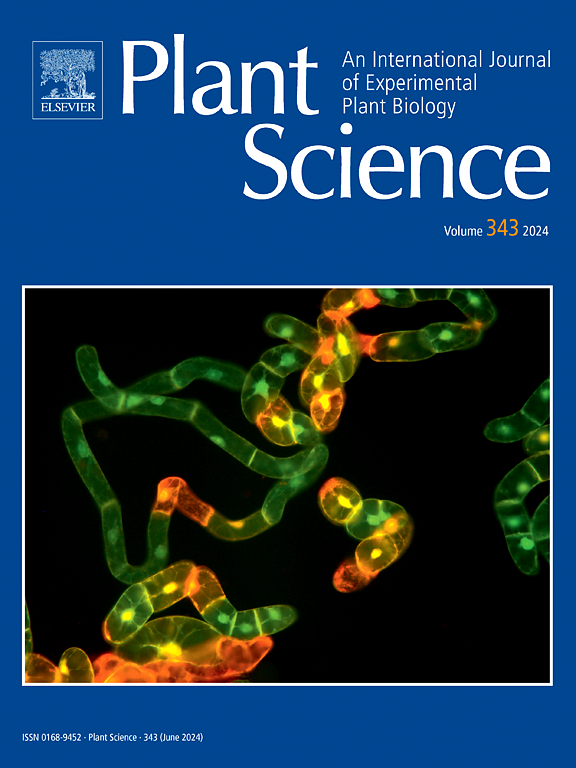The interaction complexes of TsHKT1 splicing variants enhance salt tolerance of Thellungiella salsuginea by decreasing Na+ uptake
IF 4.1
2区 生物学
Q2 BIOCHEMISTRY & MOLECULAR BIOLOGY
引用次数: 0
Abstract
HKT1 is a membrane-localized Na+/K+ cotransporter that enables plants adaptation to abiotic stresses. Extreme abiotic stresses can induce extensive alternative splicing (AS) of various genes in plants. However, the mechanisms by how splice variants contribute to stress tolerance in Thellungiella salsuginea remain unclear. Here, we demonstrated that high salinity triggers widespread AS events in T. salsuginea, with three HKT1 genes (TsHKT1;1, TsHKT1;2, and TsHKT1;3) producing six splice variants. These proteins encoded by splice variants form interaction complexes in the plasma membranes of root epidermal cells, which are capable of reducing Na+ uptake. Specifically, Heterologous expressed TsHKT1s in yeast indicated that TsHKT1;1, TsHKT1;2b, and TsHKT1;3 preferentially transport Na+ with limited K+ uptake, whereas the interaction complexes exhibit enhanced K+ uptake capacity. Ectopically expressed TsHKT1;1, TsHKT1;2a, TsHKT1;2b and TsHKT1;3 in Arabidopsis conferred salt sensitivity, while co-expression of TsHKT1;1 with TsHKT1;2b or TsHKT1;3 improved salt tolerance in Arabidopsis. Electrophysiological analyses revealed that roots of transgenic Arabidopsis coexpressing TsHKT1;1-TsHKT1;2b or TsHKT1;1-TsHKT1;3 exhibited reduced Na+ influx, particularly under low K+ and high salt conditions. These findings demonstrate that T. salsuginea employs AS to generate novel protein interaction complexes that mitigate ion toxicity, which suggests this mechanism is widely utilized by halophytes to survive in harsh environments.
TsHKT1剪接变异体的相互作用复合物通过降低Na+摄取来增强salsuginethellungiella的耐盐性。
HKT1是一种膜定位的Na+/K+共转运蛋白,使植物能够适应非生物胁迫。极端的非生物胁迫可以诱导植物多种基因广泛的选择性剪接(AS)。然而,机制如何拼接变异导致应力宽容Thellungiella salsuginea尚不清楚。在这里,我们证明了高盐度在salsuginet中引发广泛的AS事件,三个HKT1基因(TsHKT1;1, TsHKT1;2和TsHKT1;3)产生6个剪接变异体。这些由剪接变异体编码的蛋白在根表皮细胞的质膜中形成相互作用复合物,能够减少Na+的摄取。具体来说,在酵母中异源表达的TsHKT1s表明,TsHKT1;1、TsHKT1;2b和TsHKT1;3优先转运Na+, K+摄取有限,而相互作用复合物则表现出增强的K+摄取能力。在拟南芥中异位表达TsHKT1;1、TsHKT1;2a、TsHKT1;2b和TsHKT1;3使拟南芥对盐敏感,而TsHKT1;1与TsHKT1;2b或TsHKT1;3提高拟南芥的耐盐性。电生理分析显示,共表达TsHKT1;1-TsHKT1;2b或TsHKT1;1-TsHKT1;3的转基因拟南芥根部Na+内流减少,特别是在低K+和高盐条件下。这些发现表明,salsuginet利用AS产生新的蛋白质相互作用复合物来减轻离子毒性,这表明该机制被盐生植物广泛利用以在恶劣环境中生存。
本文章由计算机程序翻译,如有差异,请以英文原文为准。
求助全文
约1分钟内获得全文
求助全文
来源期刊

Plant Science
生物-生化与分子生物学
CiteScore
9.10
自引率
1.90%
发文量
322
审稿时长
33 days
期刊介绍:
Plant Science will publish in the minimum of time, research manuscripts as well as commissioned reviews and commentaries recommended by its referees in all areas of experimental plant biology with emphasis in the broad areas of genomics, proteomics, biochemistry (including enzymology), physiology, cell biology, development, genetics, functional plant breeding, systems biology and the interaction of plants with the environment.
Manuscripts for full consideration should be written concisely and essentially as a final report. The main criterion for publication is that the manuscript must contain original and significant insights that lead to a better understanding of fundamental plant biology. Papers centering on plant cell culture should be of interest to a wide audience and methods employed result in a substantial improvement over existing established techniques and approaches. Methods papers are welcome only when the technique(s) described is novel or provides a major advancement of established protocols.
 求助内容:
求助内容: 应助结果提醒方式:
应助结果提醒方式:


